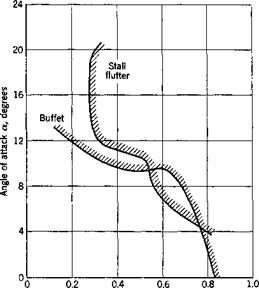BUFFETING FLUTTER OF A WING
A question arises naturally in connection with the study of tail buffeting: What happens to the wing that produces the turbulent wake? A separated flow over the wing creates aerodynamic forces that must be regarded as stochastic processes. The wing’s elastic response is necessarily also stochastic and therefore may be properly called buffeting. However, as the unsteady aerodynamic forces are produced by the wing itself, in a flow that otherwise is steady, the motion of the wing may, according to the definition of § 9.4, be called flutter. The nature of the wing motion also borders between buffeting and stall flutter described in the preceding sections. Sometimes the motion is quite random, sometimes it is quite regular, and sometimes it is a mixture of the two: e. g., random in bending, while more or less a regular sinusoidal oscillation in torsion. In order to distinguish the last feature from those described in the preceding sections, we shall use a new term: buffeting flutter.
Buffeting flutter of a wing is a problem of grave concern in transonic flight. It frequently causes wing and aileron damages.
Regarding buffeting flutter as a mixture of buffeting and stall flutter, we anticipate a situation as follows. Consider a cantilever wing. The buffeting boundary of the wing will be similar to that of the tail, because of their common origin in flow separation. For a hypothetical wing this boundary is sketched in Fig. 9.12 (cf. Fig. 9.4). On the other hand, if the stall-flutter characteristics of the wing is similar to that shown in Fig. 9.6, and if we plot the stall-flutter boundary with angle of attack as
|
Mach number, M Fig. 9.12. Buffeting flutter of a wing. |
ordinate and Mach number as abscissa, the result of Fig. 9.12 may be obtained. The relative position of these two boundaries depends on the wing planform, airfoil section, wing-fuselage junction geometry, etc. The boundaries as shown in Fig. 9.12 intersect each other. The wing motion beyond the buffet boundary is random in amplitude and frequency, and in general is predominantly bending, with very small torsional motion. As the stall-flutter boundary is reached, torsional motion of more or less regular amplitude and frequency takes place, while random motion in bending may continue.
One may question the definitiveness of the terms buffeting, stall flutter, and buffeting flutter. Indeed, since fluctuations in the flow, whether
caused by the wing itself or by other means, are the basic reason of all these phenomena, it is impossible to distinguish them with absolute clarity. Therefore they should be interpreted only as descriptive terms useful for engineering purpose: Buffeting characterizes the irregularity of the motion, stall flutter the more or less regular oscillations, and buffeting flutter a mixture of the two in different degrees of freedom.
As mentioned before, buffeting flutter is a serious problem in high-speed flight. Flight at high subsonic Mach numbers is often troubled by strong shock-wave formation and associated boundary-layer separation. A tendency of strong pressure pulsation over the wing exists, particularly in the region of the shock wave. This pressure pulsation becomes irregular when the angle of attack is sufficiently large. The intensity of this pressure pulsation can be mitigated by reducing the thickness of the airfoil and limiting the angle of attack.
As the basic cause of buffeting at high Mach number is the shock-wave formation and boundary-layer separation, the buffeting boundary should be related closely to the characteristics of the curve of lift coefficient versus Mach number. The “Mach number of divergence” of the wing (cf. § 4.3) may serve as a good estimate of the buffeting boundary at high speed. For the same reason, by reducing the wing thickness, by a proper control of the leading-edge camber which reduces the possibility of flow separation at the leading edge in moderate angles of attack, by sufficient sweepback, by using smaller aspect ratio, and by other auxiliary means, one can hope to design a wing that is practically free from buffeting throughout the transonic speed range. In supersonic flight, when the shock wave is attached to the leading edge of the wing, buffeting does not seem to be a serious problem.
An allied problem of buffeting of aircraft structures due to fluctuating loads induced by a jet is discussed by Miles.9 42
The phenomena of buffeting, stall flutter and buffeting flutter are profoundly interesting physical phenomena which still defy satisfactory mathematical analysis.












